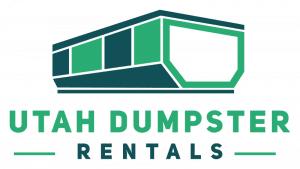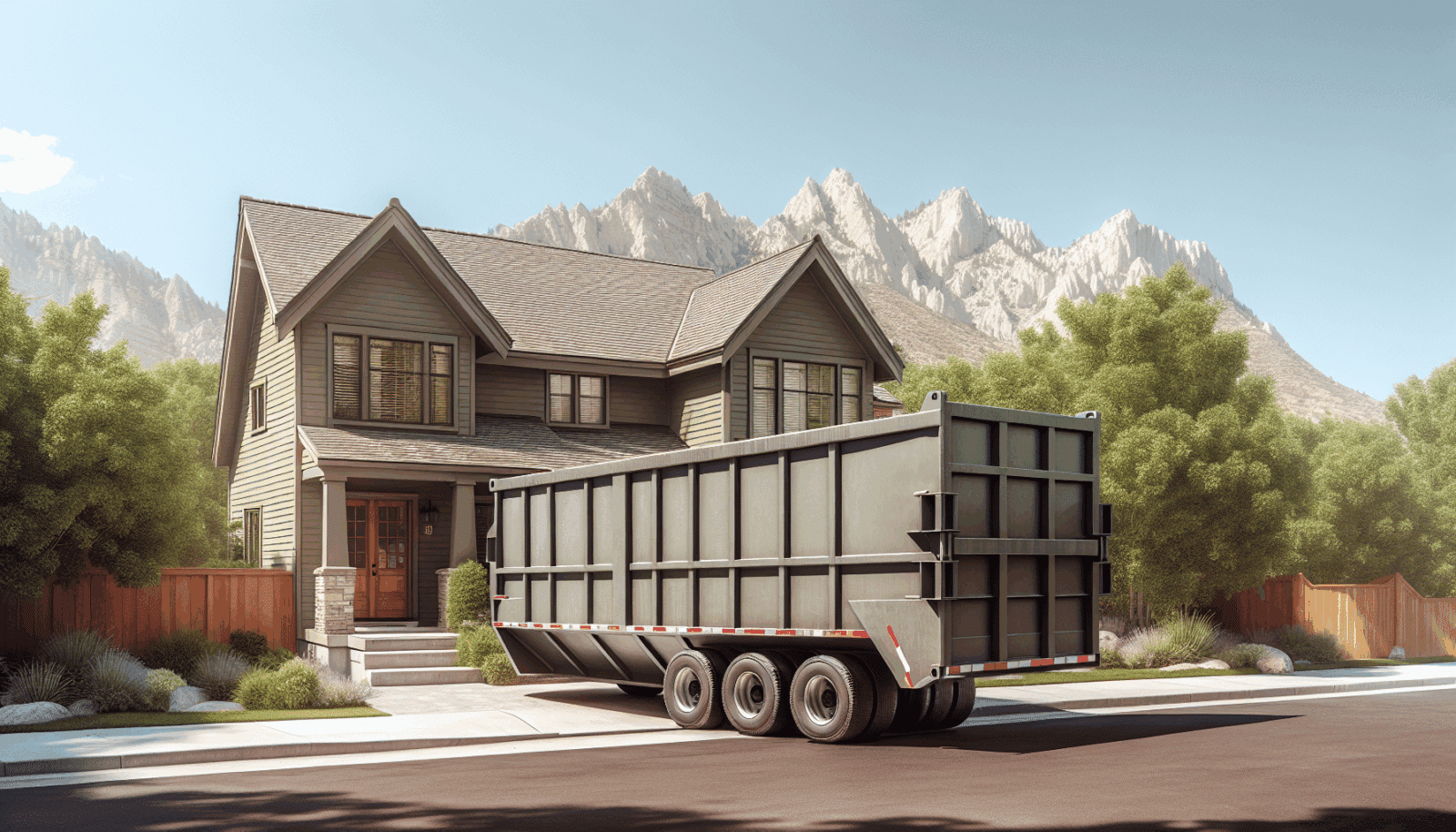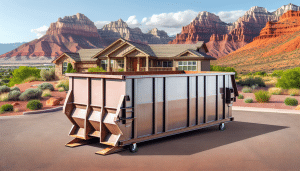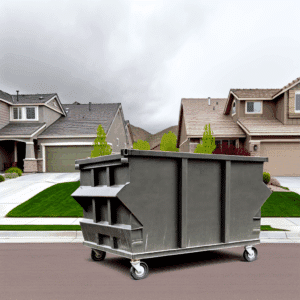Choosing the right dumpster size for a roofing project can be a perplexing task for homeowners. At Utah Dumpster Rentals, we understand this challenge and are here to guide you. This article is designed to help homeowners in Utah make an informed decision about Dumpster Sizes for their roofing tasks. Stay with us, and you’ll find the perfect fit for your project.
Contents
- 1 Understanding Your Roofing Project’s Scope
- 2 Types of Roofing Materials and Their Impact
- 3 The Different Dumpster Sizes
- 4 Factors to Consider When Choosing a Dumpster Size
- 4.1 Volume of Debris The more extensive the roofing project, the larger the volume of debris you’ll generate. Estimate the amount of waste to avoid multiple trips to the landfill.
- 4.2 Weight of Materials Heavy materials like asphalt shingles require a dumpster that can accommodate their weight without compromising safety. Light materials will allow for smaller dumpster sizes.
- 4.3 Project Duration Longer projects might generate more waste over time. Choose a dumpster size that can accommodate the waste over the project’s duration.
- 4.4 Accessibility Consider where the dumpster will be placed. A large dumpster may be difficult to position in tight spaces; a smaller one could be more practical.
- 4.5 Cost Larger dumpsters cost more to rent. Evaluate your budget and choose the most cost-effective size that meets your needs.
- 5 Assessing Your Waste Generation
- 6 Planning for Efficient Loading
- 7 Consulting with Professionals
- 8 Cost Implications of Different Dumpster Sizes
- 9 Safety and Environmental Concerns
Understanding Your Roofing Project’s Scope
Before diving into dumpster sizes, it’s crucial to understand the scope of your roofing project. Are you doing a complete tear-off or just a minor repair? The volume of waste generated can vary significantly based on these details.
First, estimate the total square footage of the roof area that will be replaced or repaired. Keep in mind the type of material being removed. Asphalt shingles, for instance, are heavier and bulkier than other roofing materials.
Types of Roofing Materials and Their Impact
Different roofing materials require different dumpster sizes. For instance, metal roofing shingles take up less space compared to traditional asphalt shingles. Knowing what kind of material you’ll be disposing of will help you choose the right dumpster.
Moreover, think about the weight of the materials. Asphalt shingles are not only bulky but also heavy, so a larger dumpster that can handle the weight is essential. Conversely, if you have lightweight materials, you can probably get away with a smaller dumpster.
The Different Dumpster Sizes
At Utah Dumpster Rentals, we offer a variety of dumpster sizes to suit your needs. Here’s a brief overview of the options available:
10-Yard Dumpster
Ideal for smaller projects, like a single-room remodeling or a minor roof repair. It holds up to 10 cubic yards of waste.
20-Yard Dumpster
A versatile option suitable for moderate roofing projects. It can easily hold 20 cubic yards of waste and is perfect for most single-layer roof tear-offs.
30-Yard Dumpster
This larger option is better suited for bigger projects. If you’re replacing multiple layers of shingles or redoing an entire roof, the 30-yard dumpster is your best bet.
Factors to Consider When Choosing a Dumpster Size
Several factors can influence your choice of dumpster size. Here are some considerations to keep in mind:
- Volume of Debris
The more extensive the roofing project, the larger the volume of debris you’ll generate. Estimate the amount of waste to avoid multiple trips to the landfill.
The more extensive the roofing project, the larger the volume of debris you’ll generate. Estimate the amount of waste to avoid multiple trips to the landfill.
Weight of Materials Heavy materials like asphalt shingles require a dumpster that can accommodate their weight without compromising safety. Light materials will allow for smaller dumpster sizes.
Project Duration Longer projects might generate more waste over time. Choose a dumpster size that can accommodate the waste over the project’s duration.
Accessibility Consider where the dumpster will be placed. A large dumpster may be difficult to position in tight spaces; a smaller one could be more practical.
Cost Larger dumpsters cost more to rent. Evaluate your budget and choose the most cost-effective size that meets your needs.
Assessing Your Waste Generation
Take an inventory of the waste materials you’ll be generating. Note the types of shingles and other debris that need disposal. This helps in choosing a dumpster size that fits your specific needs.
Additionally, be mindful of any other materials that might be mixed with the roofing debris, such as wood or nails. These extra materials can quickly add up, requiring more space.
Planning for Efficient Loading
Effective packing and loading of the dumpster will maximize its utility. Place heavier, bulkier items on the bottom and lighter, more compact waste on top. This systematic approach ensures you get the most out of your chosen dumpster size.
Not to mention, breaking down large items can also help save space. The more you can compact the waste, the more you’ll fit, potentially allowing for a smaller and more cost-effective dumpster.
Consulting with Professionals
Lastly, don’t hesitate to consult with us at Utah Dumpster Rentals. We have years of experience helping homeowners choose the perfect dumpster size for their projects. We’re more than happy to offer personalized advice and come up with the best solution tailored to your needs.
Our customer service team is always ready to answer any questions you might have. So, if you’re unsure, just give us a call, and we’ll guide you through the process.
Cost Implications of Different Dumpster Sizes
It’s important to consider the cost implications of various dumpster sizes. A larger dumpster will naturally cost more to rent compared to a smaller one. However, multiple trips with a smaller dumpster can end up being more expensive.
Choose a size that offers the best balance between capacity and cost. Think about how quickly you want to complete your project and factor that into your decision-making process.
Safety and Environmental Concerns
Lastly, be mindful of safety and environmental regulations when choosing a dumpster size. Overfilled dumpsters can be hazardous and might result in additional fees. Ensure that your chosen dumpster can handle all your waste without exceeding legal limits.
Recycling materials where possible is also a good practice. This helps reduce the overall volume of waste that needs to be disposed of, potentially allowing you to opt for a smaller, less expensive dumpster.
By following these tips and trusting Utah Dumpster Rentals, you can make your roofing project a breeze. Remember, the right dumpster size can save you time, money, and effort. For more personalized advice, Contact Us directly at 801-901-9871 or Request a Free Quote.




